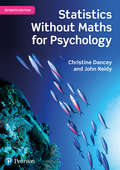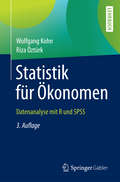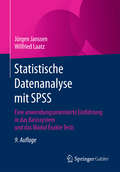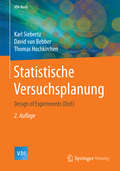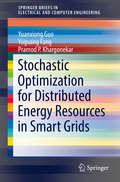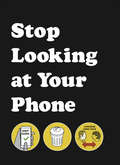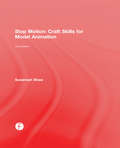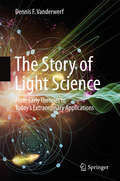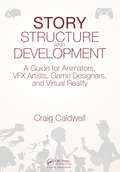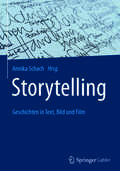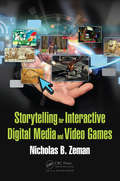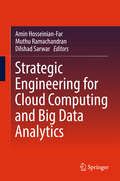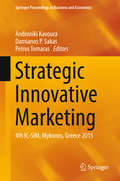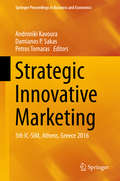- Table View
- List View
Statistical Modelling of Survival Data with Random Effects: H-Likelihood Approach (Statistics for Biology and Health)
by Il Do Ha Jong-Hyeon Jeong Youngjo LeeThis book provides a groundbreaking introduction to the likelihood inference for correlated survival data via the hierarchical (or h-) likelihood in order to obtain the (marginal) likelihood and to address the computational difficulties in inferences and extensions. The approach presented in the book overcomes shortcomings in the traditional likelihood-based methods for clustered survival data such as intractable integration. The text includes technical materials such as derivations and proofs in each chapter, as well as recently developed software programs in R (“frailtyHL”), while the real-world data examples together with an R package, “frailtyHL” in CRAN, provide readers with useful hands-on tools. Reviewing new developments since the introduction of the h-likelihood to survival analysis (methods for interval estimation of the individual frailty and for variable selection of the fixed effects in the general class of frailty models) and guiding future directions, the book is of interest to researchers in medical and genetics fields, graduate students, and PhD (bio) statisticians.
Statistics for Data Science
by James D. MillerThis book will start off with simple statistics and then move on to statistical methods that are used in data science algorithms. The R programs for the statistical computations will be clearly explained along with the logic. You will come across various mathematical concepts such as variance, standard deviation, probability, matrix calculations, and more. You will learn only what is required to implement statistics in data science tasks such as data cleaning, mining, and analysis.
Statistics for Machine Learning
by Pratap DangetiBuild Machine Learning models with a sound statistical understanding. About This Book • Learn about the statistics behind powerful predictive models with p-value, ANOVA, and F- statistics. • Implement statistical computations programmatically for supervised and unsupervised learning through K-means clustering. • Master the statistical aspect of Machine Learning with the help of this example-rich guide to R and Python. Who This Book Is For This book is intended for developers with little to no background in statistics, who want to implement Machine Learning in their systems. Some programming knowledge in R or Python will be useful. What You Will Learn • Understand the Statistical and Machine Learning fundamentals necessary to build models • Understand the major differences and parallels between the statistical way and the Machine Learning way to solve problems • Learn how to prepare data and feed models by using the appropriate Machine Learning algorithms from the more-than-adequate R and Python packages • Analyze the results and tune the model appropriately to your own predictive goals • Understand the concepts of required statistics for Machine Learning • Introduce yourself to necessary fundamentals required for building supervised & unsupervised deep learning models • Learn reinforcement learning and its application in the field of artificial intelligence domain In Detail Complex statistics in Machine Learning worry a lot of developers. Knowing statistics helps you build strong Machine Learning models that are optimized for a given problem statement. This book will teach you all it takes to perform complex statistical computations required for Machine Learning. You will gain information on statistics behind supervised learning, unsupervised learning, reinforcement learning, and more. Understand the real-world examples that discuss the statistical side of Machine Learning and familiarize yourself with it. You will also design programs for performing tasks such as model, parameter fitting, regression, classification, density collection, and more. By the end of the book, you will have mastered the required statistics for Machine Learning and will be able to apply your new skills to any sort of industry problem. Style and approach This practical, step-by-step guide will give you an understanding of the Statistical and Machine Learning fundamentals you'll need to build models.
Statistics Without Maths for Psychology
by John Reidy Prof Christine DanceyThis is the enhanced ebook for Dancey and Reidy, Statistics without Maths for Psychology 7eThis enhanced ebook version of Statistics without Maths for Psychology 7e contains a selection of additional interactive features specifically designed to support you in your study, including: Multiple choice questions with dedicated and immediate feedback are embedded at the end of key sections to enable you to check your understanding and manage your progress. Video screencasts provide step by step walk-throughs to show you in detail how to carry out a full range of SPSS procedures.End of chapter quiz with dedicated feedback allows you to check your knowledge of key topics and concepts and help you prepare for exams.Highly praised for its clear, straightforward approach, Statistics without Maths 7th edition provides a comprehensive and accessible introduction to statistics and SPSS. This widely used and trusted textbook is packed with examples, activities and questions to help you to test your learning and deepen your understanding in a practical and manageable way. Statistics without Maths for Psychology, 7e, will help you to gain the confidence to apply statistical concepts and use SPSS to analyse data within your studies and future independent research.
Statistik für Ökonomen: Datenanalyse mit R und SPSS (Springer-Lehrbuch)
by Wolfgang Kohn Riza ÖztürkDas Buch richtet sich an diejenigen, die Statistik in wirtschaftswissenschaftlich orientierten Studiengängen studieren. Der leicht verständliche Text ist mit vielen Beispielen und Übungen ergänzt. Die praxisnahe Darstellung der Methoden wird durch die Erklärung und Anwendung der Statistikprogramme R (open source Progamm) und SPSS vervollständigt. Im Text sind für beide Programme viele Programmanweisungen enthalten. Die Autoren haben kompakt alle elementaren statistischen Verfahren für die Ökonomie anschaulich erklärt.
Statistik mit Excel für Dummies (Für Dummies)
by Joseph SchmullerStatistiken und Aussagen zu Wahrscheinlichkeiten begegnen uns heute überall: Die Umsatzentwicklung in Unternehmen, Hochrechnungen für Wahlergebnisse, PISA-Ergebnisse fünfzehnjähriger Schüler sind nur drei von zahlreichen Beispielen. Joseph Schmuller zeigt Ihnen in diesem Buch, wie Sie die Zahlen in den Griff bekommen und Daten, Statistiken und Wahrscheinlichkeiten richtig lesen und interpretieren. Dafür brauchen Sie keinen Statistikkurs zu belegen und kein Mathegenie zu sein. Für alles gibt es in Excel die passende Funktion und das passende Werkzeug. So können Sie Theorie und Praxis sofort miteinander verbinden.
Statistik mit R für Dummies (Für Dummies)
by Joseph SchmullerAls angehender Wissenschaftler, Manager oder Unternehmensberater sind Sie darauf angewiesen, Daten mit statistischen Methoden fehlerfrei auszuwerten und die Ergebnisse überzeugend darzustellen? Statistik ist allerdings nicht gerade Ihr Fachgebiet? Dann ist dieses Buch genau richtig für Sie. In jedem Kapitel führt der Autor eine statistische Methode vor und erklärt, was man an den Ergebnissen ablesen kann und was nicht. Unmittelbar im Anschluss beschreibt er, wie man die Methode in R implementiert. Denn R lässt mit den dazugehörigen Paketen keine Wünsche in der Statistik offen. In der Regel genügen wenige Zeilen Programmcode. Und das Beste ist: Die statistischen Pakete von R sind kostenlos. Dieses Buch hilft, bessere Entscheidungen zu treffen und Datenmüll zu vermeiden.
Statistische Datenanalyse mit SPSS: Eine anwendungsorientierte Einführung in das Basissystem und das Modul Exakte Tests
by Jürgen Janssen Wilfried LaatzDieses Buch liefert Anfängern einen leichten Einstieg in SPSS und dient erfahrenen Nutzern (auch früherer Programmversionen) zugleich als hervorragendes Nachschlagewerk. Die Nutzung des Buchs ist dabei weitgehend ohne mathematische Vorkenntnisse möglich. Die Methoden und deren Anwendung mit SPSS werden anschaulich anhand von Beispielen aus der Praxis erläutert. Auf der Internetseite zum Buch sind alle Datensätze, ergänzende Texte, Übungsaufgaben mit ihren Lösungen sowie weitere Informationen verfügbar.Die 9. Auflage dieses Buchs basiert auf IBM SPSS Statistics 24 (Base und Exact Tests). Im Rahmen der Neuauflage wurden etliche Kapitel überarbeitet. Hinzugekommen sind Kapitel zu neuen statistischen Verfahren sowie ein Übersichtskapitel zu Signifikanztests: Letzteres erleichtert es dem SPSS-Nutzer, aus der Vielzahl der in SPSS verfügbaren Tests den für seine Aufgabenstellung richtigen zu wählen.
Statistische Versuchsplanung: Design of Experiments (DoE) (VDI-Buch)
by Karl Siebertz David Van Bebber Thomas HochkirchenDie statistische Versuchsplanung (Design of Experiment, DoE) ist ein Verfahren zur Analyse von (technischen) Systemen. Dieses Verfahren ist universell einsetzbar und eignet sich sowohl zur Produkt- als auch zur Prozessoptimierung, insbesondere dann, wenn viele Einflussgrößen zu berücksichtigen sind. Hauptanliegen der Autoren ist es, die Planung und Durchführung von systematischen Versuchsreihen mit engem Praxisbezug darzustellen. Industriespezifische Probleme illustrieren sie anhand zahlreicher Fallbeispiele.
Stochastic H2/H ∞ Control: A Nash Game Approach
by Weihai Zhang Lihua Xie Bor-Sen ChenThe H∞ control has been one of the important robust control approaches since the 1980s. This book extends the area to nonlinear stochastic H2/H∞ control, and studies more complex and practically useful mixed H2/H∞ controller synthesis rather than the pure H∞ control. Different from the commonly used convex optimization method, this book applies the Nash game approach to give necessary and sufficient conditions for the existence and uniqueness of the mixed H2/H∞ control. Researchers will benefit from our detailed exposition of the stochastic mixed H2/H∞ control theory, while practitioners can apply our efficient algorithms to address their practical problems.
Stochastic H2/H ∞ Control: A Nash Game Approach
by Weihai Zhang Lihua Xie Bor-Sen ChenThe H∞ control has been one of the important robust control approaches since the 1980s. This book extends the area to nonlinear stochastic H2/H∞ control, and studies more complex and practically useful mixed H2/H∞ controller synthesis rather than the pure H∞ control. Different from the commonly used convex optimization method, this book applies the Nash game approach to give necessary and sufficient conditions for the existence and uniqueness of the mixed H2/H∞ control. Researchers will benefit from our detailed exposition of the stochastic mixed H2/H∞ control theory, while practitioners can apply our efficient algorithms to address their practical problems.
Stochastic Optimization for Distributed Energy Resources in Smart Grids (SpringerBriefs in Electrical and Computer Engineering)
by Yuanxiong Guo Yuguang Fang Pramod P. KhargonekarThis brief focuses on stochastic energy optimization for distributed energy resources in smart grids. Along with a review of drivers and recent developments towards distributed energy resources, this brief presents research challenges of integrating millions of distributed energy resources into the grid. The brief then proposes a novel three-level hierarchical architecture for effectively integrating distributed energy resources into smart grids. Under the proposed hierarchical architecture, distributed energy resource management algorithms at the three levels (i.e., smart home, smart neighborhood, and smart microgrid) are developed in this brief based on stochastic optimization that can handle the involved uncertainties in the system.
Stochastic Partial Differential Equations for Computer Vision with Uncertain Data (Synthesis Lectures on Visual Computing: Computer Graphics, Animation, Computational Photography and Imaging)
by Tobias Preusser Robert M. Kirby Torben PätzIn image processing and computer vision applications such as medical or scientific image data analysis, as well as in industrial scenarios, images are used as input measurement data. It is good scientific practice that proper measurements must be equipped with error and uncertainty estimates. For many applications, not only the measured values but also their errors and uncertainties, should be—and more and more frequently are—taken into account for further processing. This error and uncertainty propagation must be done for every processing step such that the final result comes with a reliable precision estimate. The goal of this book is to introduce the reader to the recent advances from the field of uncertainty quantification and error propagation for computer vision, image processing, and image analysis that are based on partial differential equations (PDEs). It presents a concept with which error propagation and sensitivity analysis can be formulated with a set of basic operations. The approach discussed in this book has the potential for application in all areas of quantitative computer vision, image processing, and image analysis. In particular, it might help medical imaging finally become a scientific discipline that is characterized by the classical paradigms of observation, measurement, and error awareness. This book is comprised of eight chapters. After an introduction to the goals of the book (Chapter 1), we present a brief review of PDEs and their numerical treatment (Chapter 2), PDE-based image processing (Chapter 3), and the numerics of stochastic PDEs (Chapter 4). We then proceed to define the concept of stochastic images (Chapter 5), describe how to accomplish image processing and computer vision with stochastic images (Chapter 6), and demonstrate the use of these principles for accomplishing sensitivity analysis (Chapter 7). Chapter 8 concludes the book and highlights new research topics for the future.
Stop Looking at Your Phone: A Helpful Guide
by Son of AlanHaven’t you got something better to do?Our streets are filled with down-facing zombies, blocking up the pavements.We’d rather Instagram our food than eat it.We've forgotten how to have real actual conversations .And in the bedroom… well, that’s no place for Candy Crush Saga.It’s time we all repeated the life-changing maxim: STOP LOOKING AT YOUR PHONE. In his wonderfully deadpan instruction manual for our increasingly tunnel-visioned lives, illustrator Son of Alan taps into the strange truth of our obsession with the tiny screen. Revealing how ludicrous we've all become, and what wonders lie in stall for us a whole metre from our faces, this book will make you want to reclaim your life, your friends and your family from the tyranny of the backlit screen. You’ll laugh, sure, but it might also change your life.
Stop Motion: Craft Skills For Model Animation
by Susannah ShawStop motion animation is a challenging and time-consuming skill that requires patience, adaptability, and a close eye to detail. Stop Motion: Craft Skills for Model Animation, 3rd Edition is the essential guide to help stop motion animators overcome these challenges of this highly-skilled craft. Author Susannah Shaw provides a step-by-step guide to creating successful stop motioin films. Starting with some basic exercises, the reader will learn about developing a story, making models, creating sets and props, the mechanics of movements, filming postproduction, and how to set about finding that first elusive job in a modern studio. Key Features Interviews with current stars, step-by-step examples, coverage of Rapid Prototyping and Dragonframe Software
Stop Motion: Craft Skills for Model Animation
by Susannah ShawStop motion animation is a challenging and time-consuming skill that requires patience, adaptability, and a close eye to detail. Stop Motion: Craft Skills for Model Animation, 3rd Edition is the essential guide to help stop motion animators overcome these challenges of this highly-skilled craft. Author Susannah Shaw provides a step-by-step guide to creating successful stop motioin films. Starting with some basic exercises, the reader will learn about developing a story, making models, creating sets and props, the mechanics of movements, filming postproduction, and how to set about finding that first elusive job in a modern studio. Key Features Interviews with current stars, step-by-step examples, coverage of Rapid Prototyping and Dragonframe Software
The Story of Light Science: From Early Theories to Today's Extraordinary Applications
by Dennis F. VanderwerfThis book traces the evolution of our understanding and utilization of light from classical antiquity and the early thoughts of Pythagoras to the present time. From the earliest recorded theories and experiments to the latest applications in photonic communication and computation, the ways in which light has been put to use are numerous and astounding. Indeed, some of the latest advances in light science are in fields that until recently belonged to the realm of science fiction. The author, writing for an audience of both students and other scientifically interested readers, describes fundamental investigations of the nature of light and ongoing methods to measure its speed as well as the emergence of the wave theory of light and the complementary photon theory. The importance of light in the theory of relativity is discussed as is the development of electrically-driven light sources and lasers. The information here covers the range of weak single-photon light sources to super-high power lasers and synchrotron light sources. Many cutting-edge topics are also introduced, including entanglement-based quantum communication through optical fibers and free space, quantum teleportation, and quantum computing. The nature and use of "squeezed light" - e.g. for gravitational wave detection - is another fascinating excursion, as is the topic of fabricated metamaterials, as used to create invisibility cloaks. Here the reader also learns about the realization of extremely slow speed and time-reversed light. The theories, experiments, and applications described in this book are, whenever possible, derived from original references. The many annotated drawings and level of detail make clear the goals, procedures, and conclusions of the original investigators. Where they are required, all specialist terms and mathematical symbols are defined and explained.The final part of the book covers light experiments in the free space of the cosmos, and also speculates about scenarios for the cosmological origins of light and the expected fate of the photon in a dying universe.
Story Structure and Development: A Guide for Animators, VFX Artists, Game Designers, and Virtual Reality
by Craig CaldwellProfessor Craig Caldwell’s Story Structure and Development offers a clear approach to the essentials of story. It lays out the fundamental elements, principles, and structure for animators, designers, and artists so they can incorporate these concepts in their work. As a practical guide it includes extensive insights and advice from industry professionals. Readers will learn the universal patterns of story and narrative used in today’s movies, animation, games, and VR. With over 200 colorful images, this book has been designed for visual learners, and is organized to provide access to story concepts for the screen media professional and student. Readers will discover the story fundamentals referred to by every director and producer when they say "It’s all about story".
Story Structure and Development: A Guide for Animators, VFX Artists, Game Designers, and Virtual Reality
by Craig CaldwellProfessor Craig Caldwell’s Story Structure and Development offers a clear approach to the essentials of story. It lays out the fundamental elements, principles, and structure for animators, designers, and artists so they can incorporate these concepts in their work. As a practical guide it includes extensive insights and advice from industry professionals. Readers will learn the universal patterns of story and narrative used in today’s movies, animation, games, and VR. With over 200 colorful images, this book has been designed for visual learners, and is organized to provide access to story concepts for the screen media professional and student. Readers will discover the story fundamentals referred to by every director and producer when they say "It’s all about story". Key Features Consolidates into one text universal story structure used across the digital media industry Includes enormous visuals that illustrate and reinforce concepts for visual learners Organizes content for faculty to use sections in a non-linear manner Includes chapter objectives, review questions, and key terms to guide the reader
Storytelling: Geschichten in Text, Bild und Film
by Annika SchachDieses Buch beleuchtet das Trendthema Storytelling aus unterschiedlichen Perspektiven - von der narrativen Reportage im Journalismus über Story-Elemente in der Fotografie, der Mode und im Produktdesign, dem inszenierten Erlebnis in der digitalen Welt bis hin zum strategischen Einsatz von Corporate Storys in der externen und internen Unternehmenskommunikation. Die Arbeit mit Geschichten in der Kommunikation ist zwar nicht neu, der strategische Einsatz zur Vermittlung von bestimmten Inhalten und Botschaften, das Storytelling, beschäftigt jedoch aktuell diverse Disziplinen. Die Auseinandersetzung mit dieser Technik ist bereits vom Kern her interdisziplinär, denn Geschichten können in Text, Bild, Ton oder im Film erzählt werden. So umfangreich die praxisbezogene Beschäftigung mit dem Themenbereich ist, so spärlich ist der fächerübergreifende Diskurs, durch den Erkenntnisse aus den unterschiedlichen Disziplinen zusammengeführt, kontrastiert und gewinnbringend diskutiert werden können. Diese Lücke schließt dieses Buch.
Storytelling for Interactive Digital Media and Video Games
by Nicholas B. ZemanThe evolution of story-telling is as old as the human race; from the beginning, when our ancestors first gathered around a campfire to share wondrous tales through oral traditions, to today, with information and stories being shared through waves and filling screens with words and images. Stories have always surrounded us, and united us in ways other disciplines can't. Storytelling for Interactive Digital Media and Video Games lays out the construct of the story, and how it can be manipulated by the storyteller through sound, video, lighting, graphics, and color. This book is the perfect guide to aspiring storytellers as it illustrates the different manner of how and why stories are told, and how to make them "interactive." Storytelling features heavy game development as a method of storytelling and delivery, and how to develop compelling plots, characters, settings, and actions inside a game. The concept of digital storytelling will be explored, and how this differs from previous incarnations of mediums for stories Key Features: Explores the necessary elements of a story (setting, character, events, sequence, and perspective) and how they affect the viewer of the story Discusses media and its role in storytelling, including images, art, sound, video, and animation Explores the effect of interactivity on the story, such as contest TV, web-based storytelling, kiosks, and games Shows the different types of story themes in gaming and how they are interwoven Describes how to make games engaging and rewarding intrinsically and extrinsically
Storytelling for Interactive Digital Media and Video Games
by Nicholas B. ZemanThe evolution of story-telling is as old as the human race; from the beginning, when our ancestors first gathered around a campfire to share wondrous tales through oral traditions, to today, with information and stories being shared through waves and filling screens with words and images. Stories have always surrounded us, and united us in ways other disciplines can't. Storytelling for Interactive Digital Media and Video Games lays out the construct of the story, and how it can be manipulated by the storyteller through sound, video, lighting, graphics, and color. This book is the perfect guide to aspiring storytellers as it illustrates the different manner of how and why stories are told, and how to make them "interactive." Storytelling features heavy game development as a method of storytelling and delivery, and how to develop compelling plots, characters, settings, and actions inside a game. The concept of digital storytelling will be explored, and how this differs from previous incarnations of mediums for stories Key Features: Explores the necessary elements of a story (setting, character, events, sequence, and perspective) and how they affect the viewer of the story Discusses media and its role in storytelling, including images, art, sound, video, and animation Explores the effect of interactivity on the story, such as contest TV, web-based storytelling, kiosks, and games Shows the different types of story themes in gaming and how they are interwoven Describes how to make games engaging and rewarding intrinsically and extrinsically
Strategic Engineering for Cloud Computing and Big Data Analytics
by Amin Hosseinian-Far Muthu Ramachandran Dilshad SarwarThis book demonstrates the use of a wide range of strategic engineering concepts, theories and applied case studies to improve the safety, security and sustainability of complex and large-scale engineering and computer systems. It first details the concepts of system design, life cycle, impact assessment and security to show how these ideas can be brought to bear on the modeling, analysis and design of information systems with a focused view on cloud-computing systems and big data analytics. This informative book is a valuable resource for graduate students, researchers and industry-based practitioners working in engineering, information and business systems as well as strategy.
Strategic Innovative Marketing: 4th IC-SIM, Mykonos, Greece 2015 (Springer Proceedings in Business and Economics)
by Androniki Kavoura Damianos P. Sakas Petros TomarasThis book presents the latest on the theoretical approach of the contemporary issues evolved in strategic marketing and the integration of theory and practice. It seeks to make advancements in the discipline by promoting strategic research and innovative activities in marketing. The book highlights the use of data analytics, intelligence and knowledge-based systems in this area. In the era of knowledge-based economy, marketing has a lot to gain from collecting and analyzing data associated with customers, business processes, market economics or even data related to social activities. The contributed chapters are concerned with using modern qualitative and quantitative techniques based on information technology used to manage and analyze business data, to discover hidden knowledge and to introduce intelligence into marketing processes. This allows for a focus on innovative applications in all aspects of marketing, of computerized technologies related to data analytics, predictive analytics and modeling, business intelligence and knowledge engineering, in order to demonstrate new ways of uncovering hidden knowledge and supporting marketing decisions with evidence-based intelligent tools. Among the topics covered include innovative tourism marketing strategies, marketing communications in small and medium-sized enterprises (SMEs), the use of business modeling, as well as reflecting on the marketing trends and outlook for all transportation industry segments. The papers in this proceedings has been written by scientists, researchers, practitioners and students that demonstrate a special orientation in strategic marketing, all of whom aspire to be ahead of the curve based on the pillars of innovation. This proceedings volume compiles their contributions to the field, highlighting the exchange of insights on strategic issues in the science of innovation marketing.
Strategic Innovative Marketing: 5th IC-SIM, Athens, Greece 2016 (Springer Proceedings in Business and Economics)
by Androniki Kavoura Damianos P. Sakas Petros TomarasThis proceedings volume presents the latest on the theoretical approach of the contemporary issues evolved in strategic marketing and the integration of theory and practice. It highlights strategic research and innovative activities in marketing. The contributed chapters are concerned with using modern qualitative and quantitative techniques based on information technology used to manage and analyze business data, to discover hidden knowledge and to introduce intelligence into marketing processes. This allows for a focus on innovative applications in all aspects of marketing, of computerized technologies related to data analytics, predictive analytics and modeling, business intelligence and knowledge engineering, in order to demonstrate new ways of uncovering hidden knowledge and supporting marketing decisions with evidence-based intelligent tools. The chapters from the proceedings of the 5th International Conference on Strategic Innovative Marketing 2016 cover areas such as social media marketing innovation, sustainable marketing, customer satisfaction strategies, customer relationship management, marketing research and analytics. The papers have been written by scientists, researchers, practitioners and students that demonstrate a special orientation in strategic marketing, all of whom aspire to be ahead of the curve based on the pillars of innovation. This proceedings volume shares their recent contributions to the field and showcases their exchange of insights on strategic issues in the science of innovation marketing.



